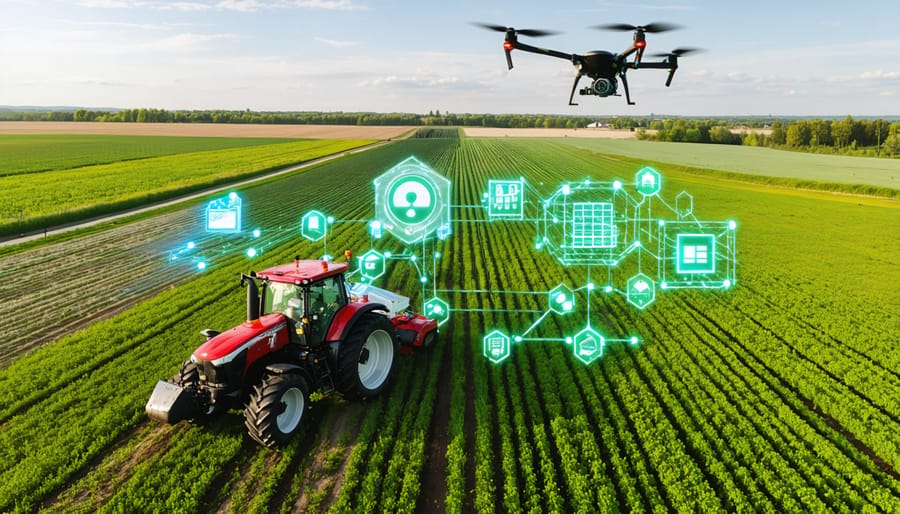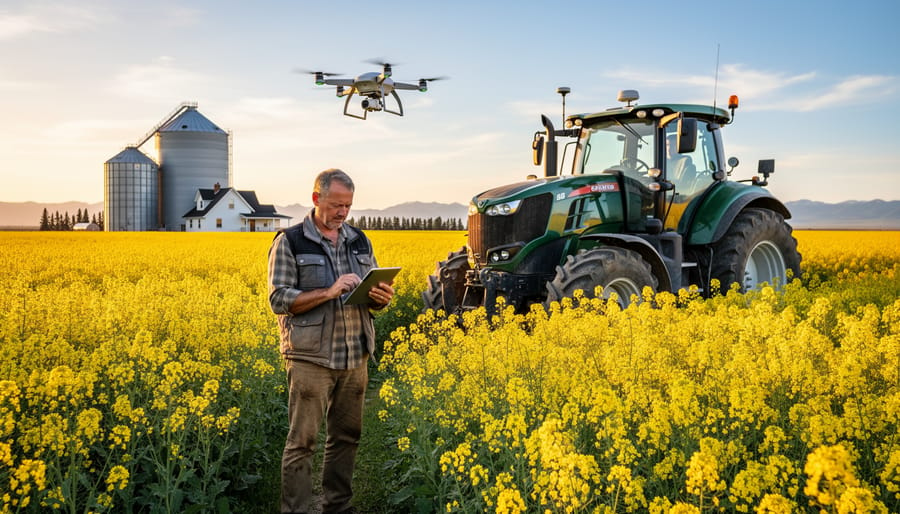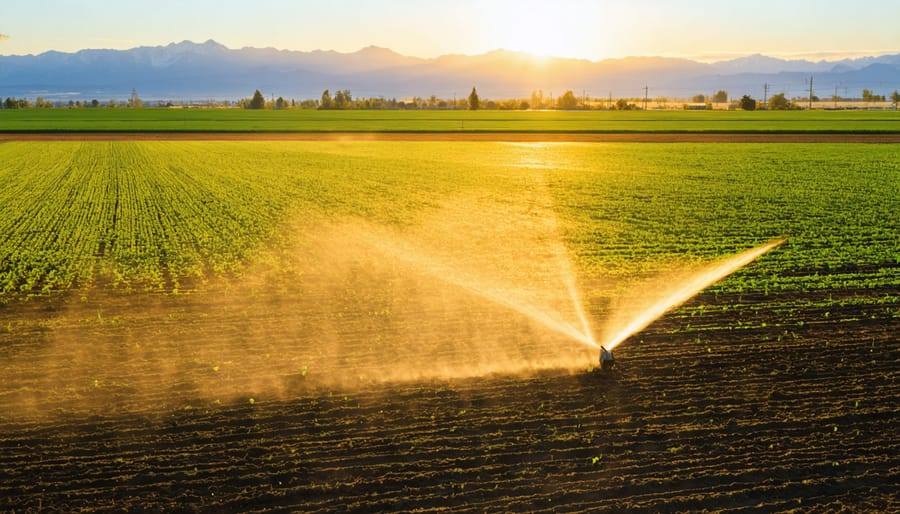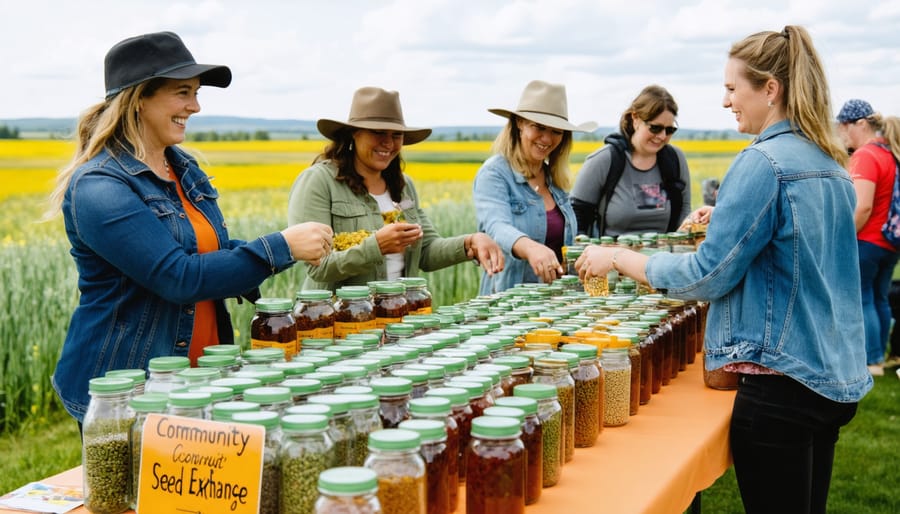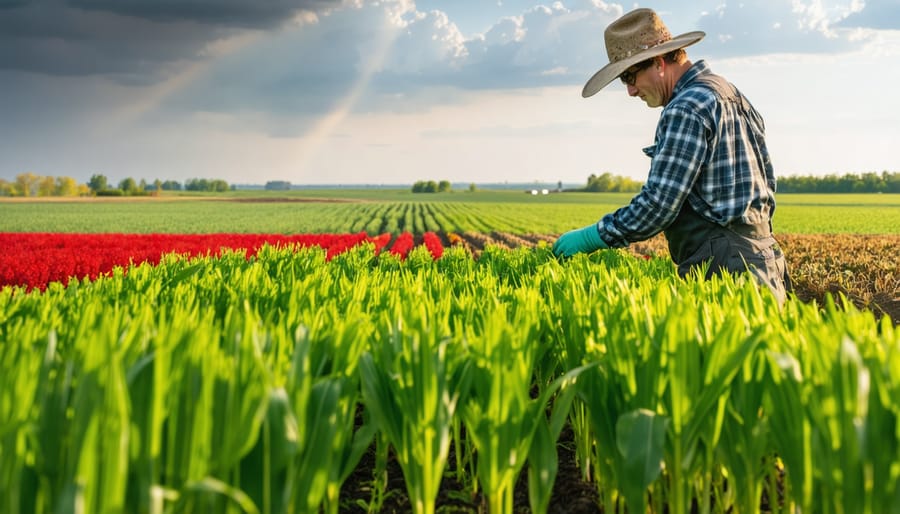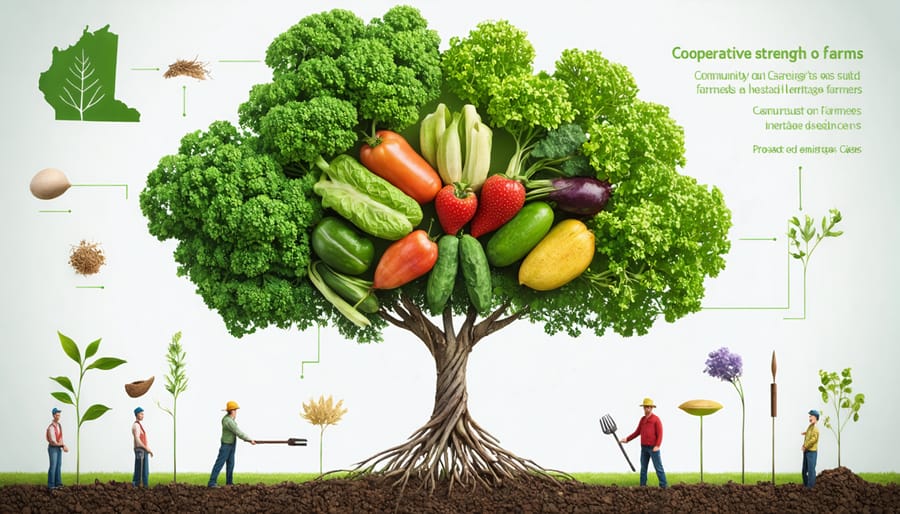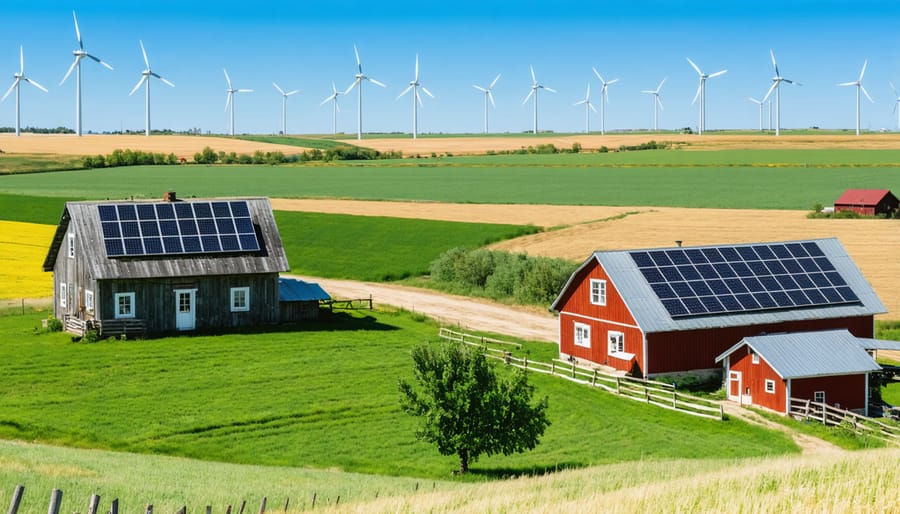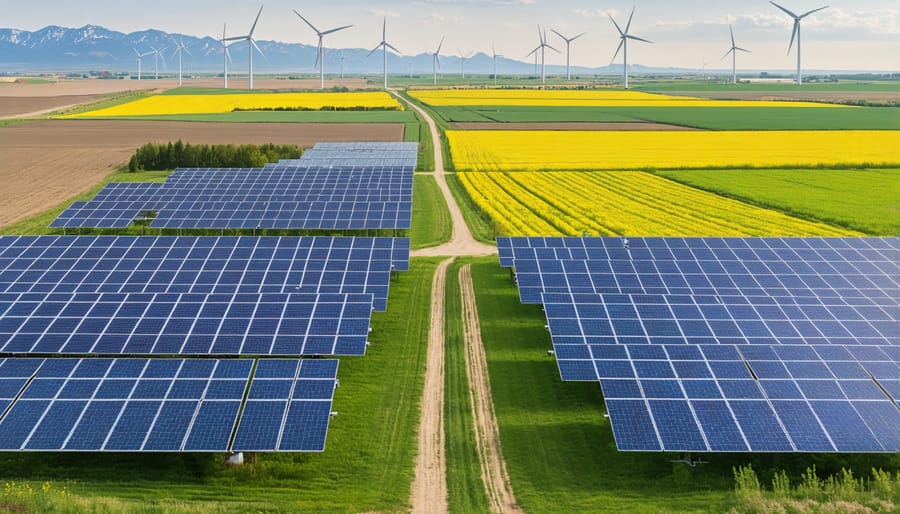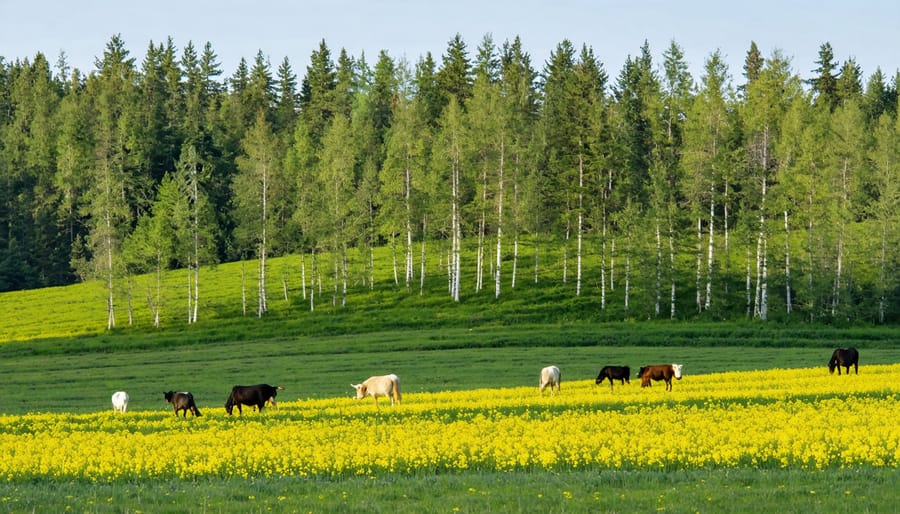Transform traditional farming operations into sustainable powerhouses by integrating climate-smart farming technologies that reduce environmental impact while boosting productivity. Precision agriculture sensors now enable Alberta farmers to cut water usage by 30% through real-time soil moisture monitoring and automated irrigation systems. GPS-guided tractors and drone mapping reduce fuel consumption by 15% while optimizing fertilizer application across fields. Smart greenhouses, powered by renewable energy and equipped with IoT sensors, extend growing seasons by four months annually while using 40% less energy than conventional systems.
Alberta’s agricultural sector stands at the forefront of sustainable innovation, where data-driven farming practices meet environmental stewardship. By combining advanced monitoring systems with traditional farming knowledge, local producers are achieving remarkable results: increased crop yields, reduced resource consumption, and enhanced soil health. These technologies don’t just protect our environment – they’re creating a more resilient and profitable future for Canadian agriculture.
This revolution in sustainable farming isn’t just about individual technologies; it’s about building an interconnected system where every decision is backed by precise data and every action serves both productivity and sustainability goals.
Precision Agriculture Technologies Reshaping Alberta’s Fields
GPS-Guided Systems and Smart Sensors
GPS-guided systems and smart sensors have revolutionized how Alberta farmers manage their operations, offering precision that wasn’t possible just a decade ago. These technologies work together to create detailed field maps, monitor soil conditions, and guide equipment with centimetre-level accuracy.
Many Alberta farmers are now using GPS auto-steering systems that can reduce overlap in seeding, spraying, and harvesting by up to 90%. This precision not only saves on fuel and inputs but also minimizes soil compaction and environmental impact. Local farmer Dave Thompson from Olds reports saving approximately 15% on fertilizer costs in his first year using GPS guidance.
Smart sensors are becoming increasingly accessible, with soil moisture probes and weather stations providing real-time data to farmers’ smartphones. These IoT devices can detect everything from soil nutrient levels to pest presence, enabling targeted responses rather than blanket applications. For instance, moisture sensors helped Red Deer County farmers reduce irrigation water usage by 30% during the 2022 growing season.
The Alberta Farm Smart Network, a collaborative initiative among local farmers, has shown that combining GPS guidance with smart sensors can lead to up to 20% reduction in input costs while maintaining or improving yields. These systems are particularly valuable during night operations and low-visibility conditions, allowing for extended working hours when needed.
For farmers just starting with these technologies, many equipment dealers offer training programs and support services to ensure smooth implementation and maximum benefit from these investments.
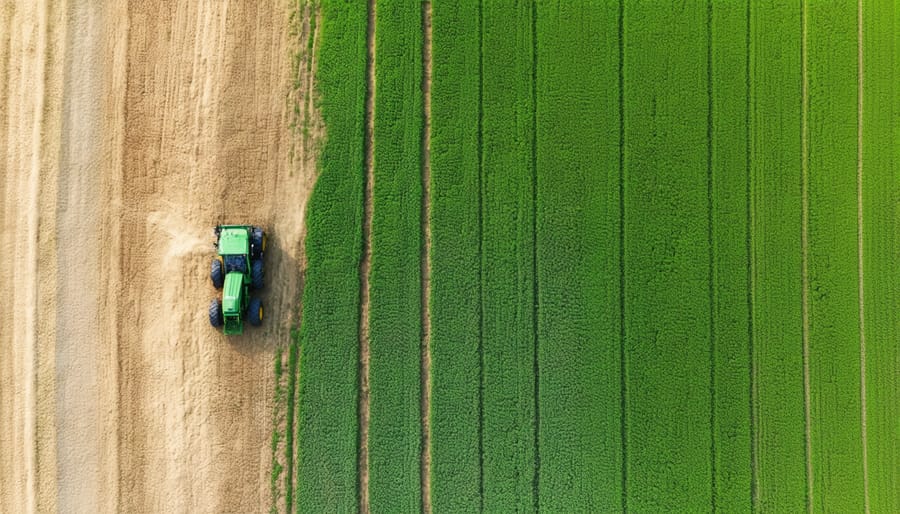
Drone Technology and Crop Monitoring
Drone technology has revolutionized how Alberta farmers monitor and manage their crops, offering an efficient and sustainable approach to precision agriculture. These aerial systems, equipped with high-resolution cameras and specialized sensors, provide detailed insights into crop health, soil conditions, and potential issues before they become visible to the naked eye.
Many Alberta farmers are now using drones to create detailed field maps and monitor crop development throughout the growing season. These systems can cover hundreds of hectares in a single flight, collecting data on plant health, moisture levels, and nutrient deficiencies. The real-time information helps farmers make precise decisions about irrigation, fertilizer application, and pest management, reducing resource waste and environmental impact.
Local farmer Dave Thompson from Lethbridge shares, “Since implementing drone monitoring on our canola fields, we’ve cut our fertilizer use by 20% while maintaining yields. The technology helps us spot problems early and treat only the areas that need attention.”
Modern agricultural drones can be equipped with multispectral sensors that detect subtle variations in crop vigour through different light wavelengths. This technology enables farmers to create prescription maps for variable-rate applications, ensuring resources are used only where needed. Some systems even integrate with farm management software, allowing for automated analysis and recommendation generation.
For farmers new to drone technology, several Alberta agricultural cooperatives offer drone-sharing programs and training sessions, making this sustainable technology more accessible to the farming community.
Data-Driven Decisions for Soil Health
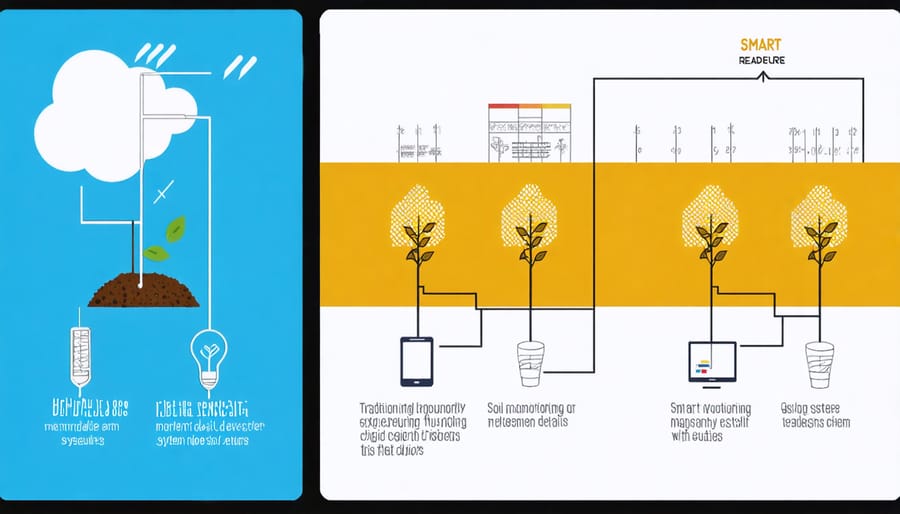
Smart Soil Testing and Analysis
Modern soil testing technology has revolutionized how Alberta farmers approach sustainable soil management practices. Today’s smart soil sensors and analysis tools provide real-time data about nutrient levels, moisture content, and microbial activity, helping farmers make informed decisions about their land.
These advanced systems use a network of wireless sensors placed throughout fields to continuously monitor soil conditions. The data is transmitted to mobile devices or computers, allowing farmers to track soil health from anywhere on their property. Many Alberta farmers are now using portable soil testing devices that provide instant results for pH levels, nitrogen content, and other crucial parameters.
Precision agriculture companies in Western Canada have developed specialized soil mapping technologies that create detailed profiles of field variations. These maps help farmers identify areas requiring specific attention, enabling targeted application of nutrients and reducing overall resource use.
Real-world applications in Southern Alberta have shown that smart soil testing can reduce fertilizer use by up to 30% while maintaining or improving crop yields. For example, the Morrison family farm near Lethbridge implemented sensor-based soil monitoring three years ago and reported significant improvements in both soil health and operational efficiency.
Local agricultural extension services now offer training programs on using these technologies, making them more accessible to farmers across the province. By combining traditional farming knowledge with modern soil testing methods, Alberta’s agricultural community is leading the way in soil health innovation and sustainable farming practices.
Automated Irrigation Systems
In Alberta’s diverse agricultural landscape, automated irrigation systems have become game-changers for water conservation and crop management. These smart systems use soil moisture sensors, weather data, and sophisticated algorithms to deliver precise amounts of water exactly when and where crops need it.
Local farmers have reported water savings of 30-40% after implementing automated systems, with some operations reducing consumption by up to 700,000 litres per growing season. These systems typically include soil moisture probes placed at various depths, weather stations that monitor environmental conditions, and centralized control units that farmers can manage through their smartphones or tablets.
“The technology has transformed how we think about water usage,” says Sarah Thompson, a third-generation farmer from Lethbridge. “We’re not just saving water; we’re seeing healthier crops and better yields because we’re providing optimal moisture levels throughout the growing cycle.”
Modern systems can be integrated with GIS mapping and satellite imagery to create irrigation zones based on soil type, crop requirements, and field topography. This precision approach ensures that areas with sandy soils receive more frequent, lighter applications, while clay-rich zones get deeper, less frequent watering.
For those considering automation, the Alberta Irrigation Technology Centre offers workshops and demonstration sites where farmers can learn about different systems and their applications. Many irrigation districts also provide cost-sharing programs to help offset the initial investment, making this technology more accessible to operations of all sizes.
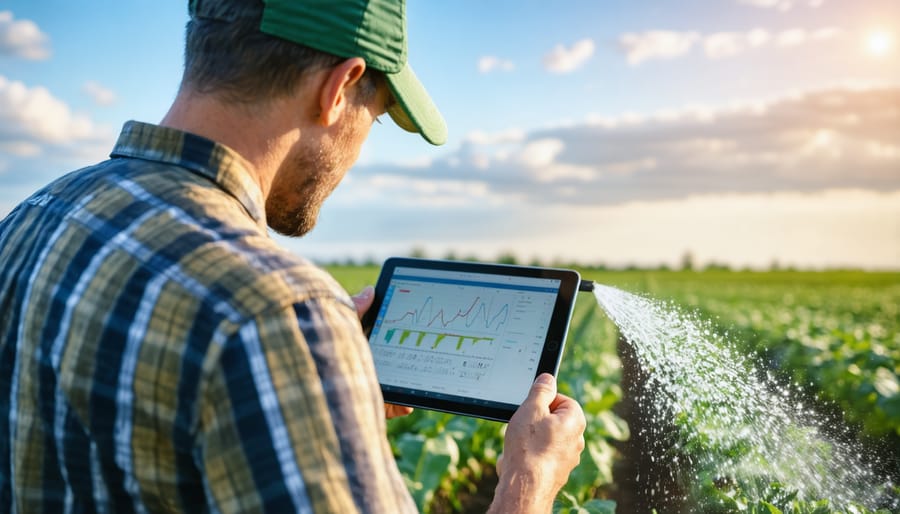
Digital Collaboration Tools
Farm Management Software
Modern farm management software has revolutionized how Alberta farmers approach sustainable agriculture. These digital tools help streamline operations while promoting environmentally conscious practices. Popular platforms like FarmCommand and Climate FieldView enable farmers to track crop rotations, monitor soil health, and optimize resource usage through user-friendly interfaces.
These systems integrate data from various sources, including weather stations, soil sensors, and equipment monitors, providing a comprehensive view of farm operations. Farmers can access real-time insights through mobile apps, making it easier to make informed decisions whether in the field or at home.
Local success stories include the Thompson family farm near Lethbridge, which reduced water usage by 30% after implementing precision irrigation software. The platform’s soil moisture tracking capabilities helped them develop more efficient watering schedules while maintaining crop yields.
Many of these tools also feature collaborative elements, allowing farmers to share data and insights with agronomists and other agricultural professionals. This connectivity has fostered a community of knowledge-sharing among Alberta producers, leading to improved sustainable practices across the region.
For those new to farm management software, several agricultural extension programs offer training sessions and support to help farmers maximize these digital tools’ benefits.
Community Learning Platforms
In today’s digital age, Canadian farmers are increasingly turning to online platforms to share knowledge and learn about sustainable agricultural practices. These virtual communities have become invaluable resources for both newcomers and experienced farmers alike. Platforms like FarmCentral Alberta and AgriLearn Canada offer structured courses, webinars, and discussion forums specifically tailored to our local growing conditions and sustainability challenges.
Social media groups and collaborative farming networks have emerged as powerful tools for real-time problem-solving and information sharing. Farmers can connect with peers, share experiences, and receive advice on implementing sustainable technologies, from soil sensors to precision irrigation systems.
Notable platforms include the Canadian Agricultural Learning Portal, which offers free courses on sustainable farming techniques, and the Alberta Sustainable Agriculture Hub, featuring region-specific guidance and case studies. These resources often include video tutorials, downloadable guides, and interactive tools that help farmers assess and improve their sustainability practices.
Many of these platforms also facilitate mentorship connections, linking experienced sustainable farmers with those beginning their journey, creating a supportive ecosystem for knowledge transfer and innovation in our agricultural community.
Real Success Stories: Alberta Farmers Leading the Way
The transformative power of agricultural technology is best illustrated through the stories of successful Alberta farmers who have embraced innovation. Take Sarah Henderson’s 800-hectare farm near Lethbridge, where precision agriculture technology has reduced water usage by 40% while maintaining crop yields. Using soil moisture sensors and automated irrigation systems, Sarah’s operation has become a model of water conservation in semi-arid farming.
In the Peace River region, the Johnson family farm has revolutionized their operation through the implementation of autonomous equipment. Their fleet of GPS-guided tractors has improved seeding accuracy by 15% and reduced fuel consumption by 25%. “The technology pays for itself,” explains Tom Johnson. “We’re seeing better yields and spending less time in the field.”
Near Red Deer, Maria Rodriguez has integrated smart greenhouse technology into her market garden operation. Using IoT sensors and automated climate control systems, she’s extended her growing season by three months and reduced energy costs by 35%. Her success has inspired neighboring farms to explore similar solutions.
The Burton family farm outside Edmonton showcases the power of data-driven decision-making. Their adoption of field mapping and yield monitoring technology has allowed them to optimize fertilizer application, resulting in a 20% reduction in input costs while maintaining productivity. “We’re farming smarter, not harder,” says Jack Burton. “The environmental benefits are just as important as the economic ones.”
These success stories share common threads: careful planning, willingness to learn, and strategic implementation of technology. Each farmer started with small-scale trials before expanding their tech adoption. They also emphasize the importance of community knowledge sharing and accessing available agricultural technology grants and support programs.
Most importantly, these pioneers demonstrate that sustainable agriculture technology isn’t just about fancy gadgets – it’s about finding the right tools to solve specific challenges while improving environmental stewardship and farm profitability.
The integration of technology in sustainable agriculture has transformed farming practices across Alberta and Canada, creating a more resilient and environmentally conscious agricultural sector. From precision farming tools to data-driven decision making, these innovations have helped our farming community reduce resource consumption while maintaining or improving yields.
The success stories we’ve witnessed in our region demonstrate that sustainable agriculture technology isn’t just about environmental stewardship – it’s about building stronger, more profitable farms for future generations. Many Alberta farmers have reported significant reductions in water usage, decreased chemical inputs, and improved soil health while maintaining competitive crop yields through smart technology adoption.
Looking ahead, the opportunities for technological advancement in sustainable agriculture are boundless. The emergence of artificial intelligence, improved sensor technologies, and enhanced data analytics will continue to provide our farming community with even more tools to farm sustainably. The key to success lies in our ability to embrace these innovations while maintaining our connection to the land and our agricultural heritage.
As we move forward, collaboration between farmers, technology providers, and agricultural researchers will be crucial. By sharing knowledge and experiences within our farming community, we can ensure that technological advances serve our needs while supporting our commitment to sustainable agriculture. The future of farming in Alberta looks promising, with technology serving as a bridge between traditional farming wisdom and modern sustainable practices.

